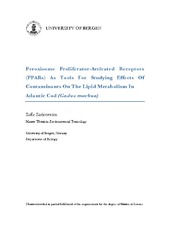| dc.description.abstract | Due to its habitats near offshore oil platforms, petroleum recovery facilities, as well as coastal industries and municipal wastewater treatment plants, Atlantic cod (Gadus morhua) must cope with both legacy and emerging environmental contaminants. Peroxisome proliferator-activated receptors (PPARs) are ligand-activated transcription factors. Upon activation by either endogenous ligands (e.g., fatty acids and lipid derivatives) or contaminants of certain structures, PPARs control the expression of genes involved in lipid- and carbohydrate metabolism. By studying how the Atlantic cod PPARs can bind and become activated by contaminants, especially by the emerging and far less documented ones, the main objective of this thesis was to contribute with new baseline data that can give insight into how the regulation of the energy metabolism in Atlantic cod can be modulated by environmental pollutants. The Atlantic cod PPARx hinge+LBDs were cloned from cod tissue using standard molecular techniques, and further subcloned into eukaryotic expression vectors. In silico sequence and phylogenetic analyses confirmed the Atlantic cod PPAR identities. The ligand-binding characteristics of Atlantic cod PPARs were examined by establishing in vitro UAS/Gal4-DBD based luciferase reporter gene assays in a COS-7 cell line. WY14643 and GW501516 are well-established model compounds that act as strong agonists of mammalian PPARα and PPARβ/δ, respectively. Similarly, WY14643 elicited a maximum activation of 126-fold on the Atlantic cod PPARαa construct at 125 μM (EC50 = 41 μM), and 128-fold on the PPARαb construct at 41 μM (EC50 = 26 μM). GW501516 elicited a maximum activation of 126-fold on the Atlantic cod PPARβ/δ construct at 11.3 μM (EC50 = 2 μM). But then, none of the typical mammalian PPARγ agonists actived the Atlantic cod PPARγ construct. However, expression of the Gal4-PPARγ construct in COS-7 cells was confirmed with Western Blotting using Gal-4 antibodies. Among fifteen pollutants tested, representing a structurally diverse group of ligands, perfluorooctanoic acid (PFOA) and perfluorononanoic acid (PFNA) were able to activate of the PPARαb construct with a maximum activation of 8-fold at 150 μM and 3-fold at 154 μM, respectively. The other ligands tested did not activate any of the Atlantic cod PPAR constructs. Thus, exposure of Atlantic cod to compounds with long carbon-backbones that harbors a carboxyl-group, could potentially modulate the lipid- and carbohydrate metabolism through directly interfering with at least one PPAR subtype. | en_US |
